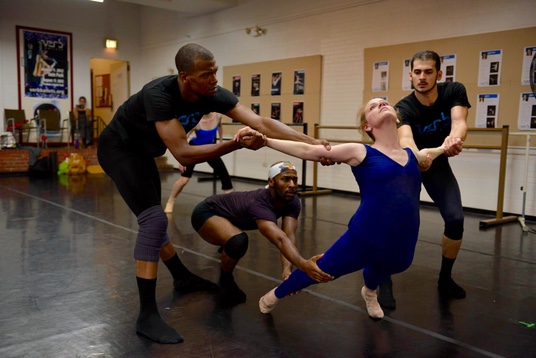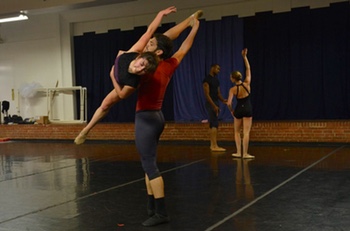
Fri 7/22-Sat 8/13
There is lots of dance in Northeast Ohio this summer, much of it outdoors and free: scroll down for a schedule of what’s coming up.
We spoke with two guest artists who choreographed new dances for Verb Ballets. Jane Startzman filled us in on the Heinz Poll Summer Dance Festival (HPSDF), which includes dance classes for children and adults as well as the free outdoor performances. And more. Five, six, seven, eight, mark your calendars!
We met with choreographer Charles Anderson at the Verb studio prior to an open rehearsal. He’d been setting his piece on the Verb dancers for the last week in June, but Aposiopesis began long before that.
Charles Anderson: I started choreographing Aposiopesis some 20 years ago and it has been re-choreographed probably five times so it’s unique in that way. The first time that I choreographed it I was very inspired by the music by Michael Nyman. Every movement is in a different time signature, 5, 4, 6. Aposiopesis rolls around in our Company C repertoire every couple of years and it also gets performed by other companies, most recently Tucson Ballet.
CoolCleveland: Why the title?
Aposiopesis? My father was a freelance choreographer for most of his life and he was also into words. An aposiopesis is a sudden break in your train of thought. We’ve all had one, so we should all know what aposiopesis means. This music originally had many movements that ended abruptly, so that’s where the word and the ballet connect. Some of those movements have been cut but you’ll notice that there’s still a break in the middle of this piece and it’s a very important one because this ballet, if it’s about anything, is about one person — it happens to be a woman — struggling with difficult parts of herself. She’s emotional, she wants this and she wants that, the kind of emotion you go through when you’re young. All of the corps members are sides of herself, echoes of her personality. The leading male character is a stable person in her life. What would you say to yourself if you met your 14-year-old self?
A lot of character in this. Looking at the highlight video we thought it was an abstract ballet but it’s not.
When I was in New York City Ballet, I worked with Jerry Robbins for nearly 10 years. When you’re in a Balanchine ballet you feel like a cog in a perfectly ticking clock. But in a Robbins ballet it was always very human and you could almost see the landscape that he created. He’d say that we don’t need to know what you’re thinking but you have to be saying something for us to receive something. So what I’ve been telling these dancers all week is, they don’t need to tell me but they need to know why they’re walking over to this person, why they’re gesturing. They all have been creating their own personal stories that run through this.
We were going to ask you about your experience with Robbins, who was notorious for harsh interactions in rehearsal. We gather that old-school abusiveness has been put aside but there’s an essence of Robbin’s method that remains in your work.
You will never see another Jerry Robbins ballet because they won’t be the same without Jerry. He could be abusive in rehearsal but I was able to let it run off my back because I knew I was working with a genius and that we were going to get a fabulous, genius piece that I would be happy to say I was in. I think a lot of people didn’t understand that Jerry wanted you to come back at him with something. If he said, “What are you doing in this ballet?” he just wanted a very assertive answer. I could tell you Jerry stories all week long but I do feel I learned a lot from Jerry.
Watching a rehearsal of Aposiopesis, we saw Anderson channel Robbins without the abuse. He questioned the Verb dancers repeatedly in terms of their motivation and emotion. “What are you running toward?” he asked one dancer. “Don’t show the drama, be the drama,” he told another. The Verb dancers seemed to be dancing full out from the beginning but as the rehearsal progressed, the dancing gradually became much, much more dynamic and interesting under Anderson’s coaching. The movement vocabulary, as Anderson told the dancers, “Goes to ballet and then it goes past ballet.”
The following week we were back in the Verb studios interviewing Roger C. Jeffrey.
CoolCleveland: We hear that you’ve made a new dance on Verb. What were your intentions?
Roger C. Jeffrey: To make a good dance where the dancers could move through space, use their full bodies, and exhibit some feelings through the movement. The title of the piece is At Your Feet and it’s inspired by Khalil Gibran’s novel Broken Wings. We pulled a couple of lines from the book, made up some phrases and choreographed a dance.
Into the garden of high affection / Where days pass like dreams.
We understand from our reading that your dances are often concerned with feelings, but we wonder in what context feelings occur in At Your Feet. Do the dancers depict characters in this piece?
No, not characters, but the dancers are storytelling based on the movement and the process that we had in the studio, trying to illuminate the idea of “high affection” and “days passing like dreams,” being in a place where anything is possible, where people are elevated through their emotions. It’s a poetic novel so I tried to create — hopefully — poetic movement.
And before and after all that they’re dancing. Again, I like pieces to move through space and dance.
How many of the Verb dancers did you use?
Three men and two ladies, so five altogether. I workshopped the movement with my company in New York, Subtle Changes, for about two weeks.
At Your Feet was not quite finished in time for the open rehearsal that we watched. The movement in some sections was still being clarified; other sections had yet to be choreographed.
“Can I see this part?” says Jeffrey as he talks the dancers through a phrase in which the three men lift Christina Lindhout by leaning into her. “I don’t need my hands,” she says as she floats toward the ceiling. Throughout rehearsal and run-through we see the women repeatedly lifted, caught while falling, and floated aloft. The choreography’s attitude toward the women is supportive and adoring, but it also hints at one of the themes of Gibran’s novel, the lack of rights for women.
As the run-through of the unfinished dance came to an end and the dancers acknowledged applause, Verb’s producing artistic sirector, Dr. Margaret Carlson, hastened to get the rehearsal back on track. “He really needs to get back to work and finish by 4pm so he can catch his plane,” she said.

We spoke with festival director Jane Startzman by phone.
CoolCleveland: We preview HPSDF every summer but this year we want to pay attention to the classes that are part of the festival. Tell us about the open children’s classes before every concert. Those are just kids who came to the concert with their parents, right?
Jane Startzman: Right. The University of Akron Dance Institute’s interactive pre-performance programs take place at 7:45pm before each of the concerts. The children look forward to those classes. On rainy days, whether we have the concert or not, we always give that pre-show class because the children would not allow us not to. Rain or shine, they come all dressed up in all kinds of tutus, wings, tights and leotards — you name it.
We understand that HPSDF has a new class format this year for children grades 2-5.
Yes, new for 2016 will be an outreach program for children in Akron neighborhoods. Reach Out and Dance (ROAD) will offer classes for three days a week in the neighborhood community center nearest the site of the weekend concert. This is the outreach program of Ballet Excel Ohio, the same ROAD that’s been in Northeast Ohio Schools since 1998. Each of the local companies performing in HPSDF will send a dancer to interact with the children’s class. All classes are taught by professional dancers. The classes are free and no prior experience is necessary.
We had never heard of ROAD until we started researching this year’s HPSDF, but ROAD owes much of its DNA to Lori Klinger, who returned to Northeast Ohio from NYC where she worked for years teaching and developing dance curricula for National Dance Institute and Rosie’s Theater Kids, two highly successful programs that bring arts training to the schools.
What we like about ROAD is it’s a way to reach in deeper to the neighborhoods. I’m hoping this will grow. The more opportunity we give people for interaction and exposure the better.
Let’s not forget to mention the master classes for dancers with intermediate or higher level of technique.
This year’s Heinz Poll Summer Dance Festival starts on Fri 7/22 and runs through Sat 8/13. Its free. See complete schedule at akrondancefestival.
But HPSDF is only part of the picture of summer dance in northeast Ohio.
Starting Fri 7/15 it’s GroundWorks DanceTheater, Inlet Dance Theatre and Dancing Wheels at Cain Park.
Neos Dance Theater is part of HPSDF but you can also catch their annual fundraiser Sat 7/30 @ 6pm in Mansfield, Ohio, Ballet @ the Brickyard, where Sylvia McNair sings live.
In August check out Tremont’s Arts in August series in Lincoln Park which includes Inlet Dance Theatre, GroundWorks DanceTheater, and Verb Ballets.
The ROAD classes in the Akron community centers can be difficult to find online so we’ve written them out for you here. Classes are scheduled:
From 1-2pm Mon 7/18, Wed 7/20, Thu 7/21 at Firestone Park Community Center, 1480 Girard St, Akron, 330-375-2806.
From 10:30-11:30am Mon 7/25, Tue 7/26, Thu 7/28 at Northwest Community Center, 1730 Shatto Ave, Akron, 330-375-2849.
From 3-4pm Mon 8/1, Wed/ 8/3, Fri 8/5 at the Balch Street Fitness Center, 220 S Balch St. #A, Akron, 330-375-2446.
From 3-4pm Tue 8/9, Wed 8/10, Thu 8/11 at Reservoir Park, 1735 Hillside Terrace, Akron, 330-375-2803.
[Written by Elsa Johnson and Victor Lucas]